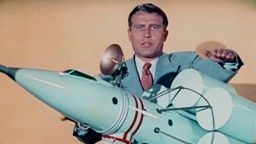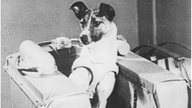In Zeitzeichen op WDR 5 vandaag aandacht voor Werner von Braun die op 23 maart 1912 werd geboren. Von Braun wordt tot op de dag van vandaag gevierd als de raketgeleerde die de eerste maanlanding met mensen mogelijk maakte, echter deze figuur heeft daarnaast een gitzwart nazi verleden…….
In de VS was men er na de Tweede Wereldoorlog (WOII) van overtuigd dat men technologisch-wetenschappelijk veel verder was dan de Sovjet-Unie (S-U), in dat geloof werd een fikse deuk geschoten door de eerste lancering in 1957 door de S-U van een raket die een satelliet in een baan om de aarde bracht, een maand later lanceerde de S-U een raket die de hond Laika in de ruimte bracht……
VS president Eisenhower gaf na die lanceringen de door de VS uit het voormalige nazi-Duitsland overgebrachte raketgeleerde en sinds 1934 SS lid Werner von Braun de opdracht om het VS satellietprogramma op gang te brengen…… Binnen drie maanden daarna brachten von Braun en zijn team de eerste VS satelliet in de ruimte. In 1959 treedt von Braun toe tot de NASA en begint aan zijn droom de eerste mens op de maan te brengen…..
Werner von Braun kan verantwoordelijk worden gesteld voor de dood van minstens 8.000 concentratiekampgevangenen die de ondergrondse ruimten moesten bouwen waar von Braun zijn massavernietigingswapens V1 en V2 ontwikkelde en die verder werden misbruikt voor het bouwen van raketten enz. Deze mensen overleden aan uitputting en honger…..
Von Braun durfde na de oorlog te zeggen dat hij niets met de tewerkstelling van concentratiekampgevangenen te maken had, een heel smerige leugen, daar hij nog in 1944 werd betrapt op het uitzoeken van gevangenen in Buchenwald, gevangenen die hij geschikt achtte voor de dwangarbeid in zijn nazi-fabrieken voor de bouw van de V2 raketten…….
Je zal verder begrijpen dat von Braun in feite ook mede
hoofdverantwoordelijk was voor de vele slachtoffers die zijn raketten
tijdens WOII hebben gemaakt, ook daarvoor werd hij niet berecht…….
Het is nog steeds een schande dat veel wetenschappers die verantwoordelijk waren voor de moord op duizenden concentratiekampgevangenen niet werden berecht maar werden overgebracht naar de VS en de Sovjet-Unie….. Uiteraard gebeurde dit destijds stiekem, daar het niet aan de volkeren was uit te leggen dat dergelijke nazi-schoften de rechterlijke dans ontsprongen, daar men ze veel te waardevol achtte om te berechten………. Overigens in Duitsland zelf mochten veel nazi-kopstukken in functie blijven, zoals rechters die onder de nazi-dictatuur mensen schreeuwend en spugend ter dood veroordeelden……
(On
the top right hand side of this page you can choose for a translation
in the language of your choice: choose ‘Engels’
[english] so you can recognise your own language [the Google
translation is first in dutch, a language most people don’t
understand, while on the other hand most people recognise there
language translated in english])
(als
je het Duits niet machtig bent, kopieer dan de Duitse tekst en plak
die in deze
vertaalapp,
de app werkt snel en de vertaling is van een redelijk goede
kwaliteit. Kopieer
het artikel en plaats het links in de app, je ziet rechts Italiaans
staan als je daar op klikt kan je kiezen voor Nederlands)
23. März 1912 – Raketeningenieur Wernher von Braun wird geboren
Stand: 23.03.2022, 10:20 Uhr
Der smarte Deutsch-Amerikaner wurde als
Mastermind der US-Raumfahrt gefeiert, als der Mann, der die erste
Mondlandung ermöglichte. Doch Wernher von Braun hat eine dunkle
Vergangenheit: In Hitlers Auftrag ließ er unter verbrecherischen
Bedingungen die V2, die “Vergeltungswaffe”, bauen.
Piepsende Funksignale aus dem Weltraum alarmieren
1957 die westliche Welt. Ausgesendet werden sie vom sowjetischen
Satelliten Sputnik 1, dem ersten von der Erde ins All beförderten
Flugkörper. Nur einen Monat später startet die UdSSR Sputnik 2 mit der Hündin Laika als erstem Weltraumpassagier.

Wernher von Braun (Geburtstag am 23.03.1912)
WDR ZeitZeichen.
23.03.2022.
14:45 Min..
Verfügbar bis 15.03.2099.
WDR 5.
Für die USA
sind die Satellitenstarts ein Schock. Mitten im Kalten Krieg war man
fest überzeugt, der Sowjetunion technologisch weit überlegen zu sein.
Das amerikanische Militär hat jedoch bislang keine einzige Rakete
erfolgreich starten können.
Präsident Eisenhower
überträgt deshalb die Verantwortung für die US-Satellitenmission einem
deutsch-amerikanischen Raketenspezialisten. Bislang hat er ihn trotz
großer Entwicklungserfolge gemieden – aus gutem Grund: Als
Ex-Oberkommandierender im Zweiten Weltkrieg weiß Eisenhower genau um die Nazi-Vergangenheit von Wernher von Braun.
Karriere als SS-Miglied
Keine drei Monate nach dem Flug von Laika schießt das Team von Wernher von Braun den ersten US-Satelliten ins All. Das Time Magazine feiert den charismatischen “Missileman” mit einem Titelblatt. 1959 wechselt von Braun zur neu gegründeten Weltraumbehörde Nasa und beginnt mit der Verwirklichung seines Lebenstraums: Menschen auf den Mond zu bringen.
Schon als Kind hat der am 23. März 1912 in Posen
geborene Sohn eines Freiherrn mit Feuerwerk gezündelt und Raketenautos
gebaut. Noch bevor von Braun sein Physik-Studium beginnt, experimentiert
er mit Raketenpionier Hermann Oberth in Berlin an Flüssigstoffraketen.
Nach seiner Promotion 1934 engagiert das Heereswaffenamt den 22-jährigen
Ingenieur. Zu diesem Zeitpunkt ist der karrierebewusste von Braun
bereits Mitglied der SS.
“Wunderwaffe” für Hitlers Endsieg

von Braun 1944 mit Offizieren der Wehrmacht in Peenemünde
In der Peenemünder Heeresversuchsanstalt leitet
Wernher von Braun ab 1937 die Entwicklung der Flüssigtreibstoffrakete
“Aggregat 4”. 1943 informiert er Hitler über die Einsatzbereitschaft der
Rakete, die nun als “Vergeltungswaffe” (V2) massenhaft produziert wird.
Rund 3.000 der angeblich kriegsentscheidenden
“Wunderwaffen” feuern die Nazis in den letzten Kriegsmonaten ab, die
meisten auf England und Rotterdam*; Tausende Menschen kommen bei den
Angriffen ums Leben.
Noch weit mehr Leben fordert die Produktion der “V2” in den unterirdischen Fabrikanlagen direkt neben dem KZ Dora-Mittelbau. Unter grausamsten Bedingungen müssen Zwangsarbeiter dort die Raketen zusammenbauen.
“Insgesamt wurden Zehntausende von KZ-Häftlingen auf Betreiben Wernher von Brauns und seiner Mitstreiter eingesetzt“, sagt Jens Christian Wagner, Historiker und Direktor der Stiftung Gedenkstätten Buchenwald. “Mindestens 8000 KZ-Häftlinge sind in diesem Raketenprogramm zu Tode geschunden worden.”
In den USA auf Mondkurs
Nach Wagners Erkenntnissen war Wernher von Braun “unmittelbar in die Planung, Anforderungen und Praxis der Zwangsarbeit von KZ-Häftlingen eingebunden“. Von Braun selbst erklärt später zu seiner Arbeit für das NS-Regime: “Ein Ingenieur im Kriege ist Soldat. An dieser Auffassung hat sich bei mir nichts geändert.”

Der “Rocket Man”: von Braun vor der Saturn-V-Mondrakete
Von Brauns Entnazifizierung nach Kriegsende ist
reine Formsache, denn im beginnenden Kalten Krieg brauchen die
Amerikaner sein Know-how. Mit 120 Mitarbeitern und 100 “V2” samt
Konstruktionsplänen im Gepäck setzt er sein Raketenprogramm in Huntsville, Alabama fort. 1949 darf er die US-Staatsbürgerschaft annehmen.
Sein Kindheitstraum geht in Erfüllung. Als
Chefkonstrukteur der mächtigen Saturn V geht Wernher von Braun in die
Raumfahrtgeschichte ein. Im Juli 1969 gelingt mit der 111 Meter hohen
Rakete die erste Landung von Menschen auf dem Mond. Der umstrittene
Raketenpionier stirbt 1977 im Alter von 65 Jahren an Nierenkrebs.
-
27. März 1968 – Todestag des Kosmonauten Juri Gagarin | mehr
-
10.02.1964 – Todestag des Raketenforschers Eugen Sänger | mehr
-
25. Mai 1961 – Kennedy kündigt bemannten Flug zum Mond an | mehr
-
24. Dezember 1968 – Apollo 8 umkreist erstmals den Mond | mehr
Autorin des Hörfunkbeitrags: Martina Meißner
Redaktion: Gesa Rünker
=========================================
* In het schrijven hierboven wordt gemeld dat de nazi’s ook V2 raketten op Rotterdam hebben ingezet, dat is een vergissing. Wel hebben de geallieerden in 1943 per ongeluk een bombardement uitgevoerd op het oostelijk havenbekken van Schiedam daarbij kwamen 326 mensen om het leven, raakten er 400 gewond en verloren 10.000 burgers hun huis” (het volgende artikel nam ik over van Oorlogsbronnen):
Rotterdam, ‘Het Vergeten Bombardement’
Het
monument ‘Het Vergeten Bombardement’ herinnert de inwoners van
Rotterdam aan het zware bombardement van 31 maart 1943 dat door de
geallieerden bij vergissing werd uitgevoerd op het havenbekken,
oostelijk van de Schiedamse scheepswerf Wilton-Feijenoord. Deze fatale
fout kostte het leven van 326 burgers en één Amerikaanse piloot, er
vielen 400 gewonden en 10.000 Rotterdammers raakten dakloos. Door een
noodlottige vergissing werden de woonwijken Bospolder en Tussendijken
zwaar getroffen door bommen van de Amerikaanse luchtmacht. Deze bommen
waren eigenlijk bedoeld voor de bezetter in het westelijke havengebied
van Delfshaven. Maar de bommen vielen op de zuidoever van de grens van
de Nieuwe Waterweg en de Maas, de Wilhelminahaven, de Keilehaven en de
Lekhaven. En op de huizen langs de Schiedamseweg, de Rozener Manzstraat
en de Mathenesserweg, tot bij het Marconiplein. Oprichting Vijftig jaar
na dato werd besloten een monument op te richten om het bombardement te
gedenken. De werkgroep ‘Het Vergeten Bombardement’ zocht contact met het
Centrum Beeldende Kunst om een blijvende herinnering in de vorm van een
monument te maken. Drie kunstenaars deden een voorstel voor een
monument: Mathieu Ficheroux, Paul Cox en René Verouden. Hun ontwerpen
werden gepresenteerd aan de bewoners van Bospolder-Tussendijken.
Uiteindelijk werd gekozen voor het ontwerp van Ficheroux. Het
gedenkteken werd gefinancierd door de CBK, het SV-fonds en sponsoring.
De kosten bedroegen 34.090 euro. Onthulling Het monument is onthuld op
31 maart 1993 door de heer Ruud Lubbers.
Overigens ook in 1942, om precies te zijn op 28 en 29 januari, vond er per vergissing een bombardement van de geallieerden plaats op Rotterdam en Schiedam daarbij kwamen 71 mensen om het leven…….. (Oorlogsbronnen ‘Bombardement op Rotterdam en Schiedam‘
—————————————–
Zie ook: ‘4,5 miljoen SA leden werden na de Tweede Wereldoorlog vrijgesproken van misdaden‘ (!!!!)
‘Monsanto, naamsverandering in Bayer om misdaden te verdoezelen……. ha! ha! ha! ha! ha! ha! ha!‘ Bayer, het bedrijf dat tijdens de Tweede Wereldoorlog (WOII) concentratiekampgevangenen misbruikte voor het testen van medicijnen en het injecteren met diverse giftige stoffen om te zien wat de reactie was op het menselijk lichaam……. Ongelofelijk genoeg mocht dit bedrijf na WOII gewoon doorgaan onder dezelfde naam en reken maar dat er hoge functionarissen van dit bedrijf op hun post mochten blijven en men gebruik is blijven maken van de gruwelijke onderzoeken die men in nazi-Duitsland had uitgevoerd….
‘Eugenetica en genetische manipulatie gaan hand in hand……‘
‘Nazimoordenaar werkte na WOII voor de Mossad…!!!‘
‘14 juli 1976 aanslag op oorlogsmisdadiger en ex-adjudant van Himmler’ (14 juli 2021)
—————————————-
En terzijde: ‘Duitse neonazi-politieagenten blijven de pers halen in ‘verward (rechts) Duitsland’‘
‘Politie van het Duitse Essen: 29 agenten zijn neonazi’s‘
‘WOII herdenking op de dag dat nazi-Duitsland 75 jaar geleden capituleerde: 8 mei 1945‘
‘Monument voor door de nazi’s vermoorde Roma en Sinti kon pas in 2012 worden onthuld……‘
‘Duitse
asielzoekerscentra worden steeds vaker aangevallen……… Ach ja het
nazi-gif is nooit echt verwijderd uit de Duitse maatschappij……‘ Hoe cynisch dat men nu (het is tijdens dit schrijven 23 maart 2022) wel vluchtelingen uit Oekraïne in grote aantallen wil opnemen, het land dat voor WOII en de inval van nazi-Duitsland voor een groot deel al fascistisch en antisemitisch was…..
‘Cees Nooteboom: Duitsland heeft tot op het bot afgerekend met het nazi verleden…..‘ (wat een sukkel!!)
‘Ulrike Meinhof, een kind van Hitler………..‘
‘Nazisme in het Duitsland van de 60er jaren, versus de opkomst van de RAF……..‘
‘AIVD waarschuwt voor het ronselen van kinderen‘
Dierenactivisme wordt door de rechtse AIVD vergeleken met terrorisme en
kinderen vertellen wat er in de intensieve martelveehouderij gebeurt is
het ronselen van kinderen….. Zo ziek als het na WOII niet vertellen
aan de kinderen uit West-Duitsland wat er in hun land en daarbuiten was
gebeurd tijdens WOII uit naam van Duitsland……
‘Derrick en de Rote Armee Fraction‘
‘Litouwse held Jonas Noreika valt van de sokkel: geen held maar een massamoordenaar van Joden‘
——————————————–
De VS gebruikte von Braun in eerste instantie voor het ontwikkelen van aanvalsraketten (dat was aanvankelijk niet erg succesvol), die dat land gebruikte voor haar terreur tegen regimes die niet gehoorzaam deden wat de VS verlangde >> voor meer berichten over de ongebreidelde VS terreur zie: ‘CIA en 70 jaar desinformatie in Europese opiniebladen…………‘
‘VS vermoordde meer dan 20 miljoen mensen sinds het einde van WOII……..‘ Daar zijn deze eeuw nog eens meer dan 5 miljoen mensen aan toegevoegd……
‘VS centraal commando werkt in Syrië samen met IS en verklaarde Rusland de oorlog………‘
‘Al Qaida de bondgenoot van de VS in de strijd tegen…… terrorisme! ha! ha! ha! ha! ha! ha! ha! ha!‘ (intussen heeft de VS ‘Al Qaida Syrië’ van de zwarte lijst met terreurorganisaties gehaald!!)
‘CIA valt nogmaals door de mand als wapenleverancier van IS…….‘





